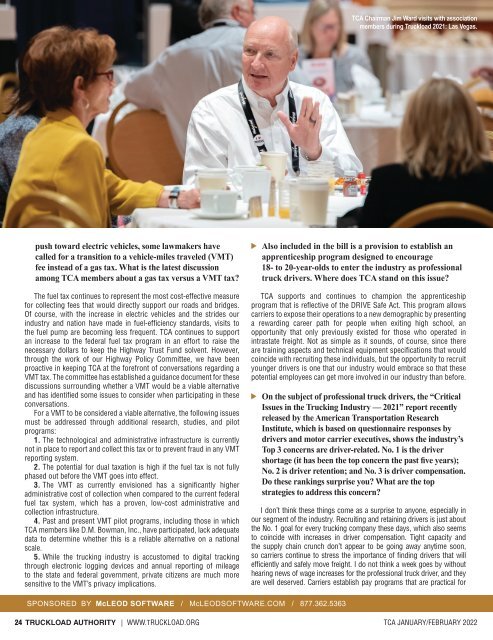You also want an ePaper? Increase the reach of your titles
YUMPU automatically turns print PDFs into web optimized ePapers that Google loves.
TCA Chairman Jim Ward visits with association<br />
members during Truckload 2021: Las Vegas.<br />
push toward electric vehicles, some lawmakers have<br />
called for a transition to a vehicle-miles traveled (VMT)<br />
fee instead of a gas tax. What is the latest discussion<br />
among TCA members about a gas tax versus a VMT tax?<br />
The fuel tax continues to represent the most cost-effective measure<br />
for collecting fees that would directly support our roads and bridges.<br />
Of course, with the increase in electric vehicles and the strides our<br />
industry and nation have made in fuel-efficiency standards, visits to<br />
the fuel pump are becoming less frequent. TCA continues to support<br />
an increase to the federal fuel tax program in an effort to raise the<br />
necessary dollars to keep the Highway Trust Fund solvent. However,<br />
through the work of our Highway Policy Committee, we have been<br />
proactive in keeping TCA at the forefront of conversations regarding a<br />
VMT tax. The committee has established a guidance document for these<br />
discussions surrounding whether a VMT would be a viable alternative<br />
and has identified some issues to consider when participating in these<br />
conversations.<br />
For a VMT to be considered a viable alternative, the following issues<br />
must be addressed through additional research, studies, and pilot<br />
programs:<br />
1. The technological and administrative infrastructure is currently<br />
not in place to report and collect this tax or to prevent fraud in any VMT<br />
reporting system.<br />
2. The potential for dual taxation is high if the fuel tax is not fully<br />
phased out before the VMT goes into effect.<br />
3. The VMT as currently envisioned has a significantly higher<br />
administrative cost of collection when compared to the current federal<br />
fuel tax system, which has a proven, low-cost administrative and<br />
collection infrastructure.<br />
4. Past and present VMT pilot programs, including those in which<br />
TCA members like D.M. Bowman, Inc., have participated, lack adequate<br />
data to determine whether this is a reliable alternative on a national<br />
scale.<br />
5. While the trucking industry is accustomed to digital tracking<br />
through electronic logging devices and annual reporting of mileage<br />
to the state and federal government, private citizens are much more<br />
sensitive to the VMT’s privacy implications.<br />
Also included in the bill is a provision to establish an<br />
apprenticeship program designed to encourage<br />
18- to 20-year-olds to enter the industry as professional<br />
truck drivers. Where does TCA stand on this issue?<br />
TCA supports and continues to champion the apprenticeship<br />
program that is reflective of the DRIVE Safe Act. This program allows<br />
carriers to expose their operations to a new demographic by presenting<br />
a rewarding career path for people when exiting high school, an<br />
opportunity that only previously existed for those who operated in<br />
intrastate freight. Not as simple as it sounds, of course, since there<br />
are training aspects and technical equipment specifications that would<br />
coincide with recruiting these individuals, but the opportunity to recruit<br />
younger drivers is one that our industry would embrace so that these<br />
potential employees can get more involved in our industry than before.<br />
On the subject of professional truck drivers, the “Critical<br />
Issues in the Trucking Industry — 2021” report recently<br />
released by the American Transportation Research<br />
Institute, which is based on questionnaire responses by<br />
drivers and motor carrier executives, shows the industry’s<br />
Top 3 concerns are driver-related. No. 1 is the driver<br />
shortage (it has been the top concern the past five years);<br />
No. 2 is driver retention; and No. 3 is driver compensation.<br />
Do these rankings surprise you? What are the top<br />
strategies to address this concern?<br />
I don’t think these things come as a surprise to anyone, especially in<br />
our segment of the industry. Recruiting and retaining drivers is just about<br />
the No. 1 goal for every trucking company these days, which also seems<br />
to coincide with increases in driver compensation. Tight capacity and<br />
the supply chain crunch don’t appear to be going away anytime soon,<br />
so carriers continue to stress the importance of finding drivers that will<br />
efficiently and safely move freight. I do not think a week goes by without<br />
hearing news of wage increases for the professional truck driver, and they<br />
are well deserved. Carriers establish pay programs that are practical for<br />
SPONSORED BY McLEOD SOFTWARE / McLEODSOFTWARE.COM / 877.362.5363<br />
24 TRUCKLOAD AUTHORITY | WWW.TRUCKLOAD.ORG TCA JANUARY/FEBRUARY 2022

















